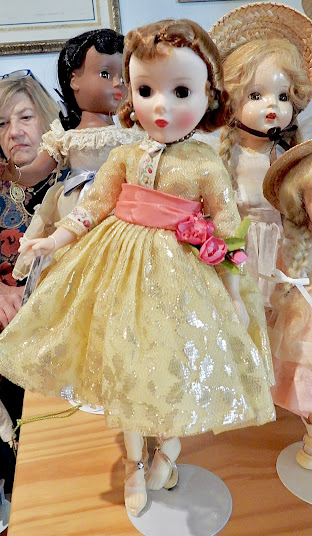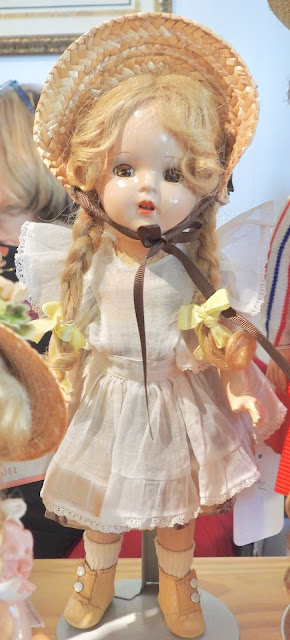Member Myrna Loesch did a program on dolls made by Michele-ette, a Mexican doll company.
She told the club that she found this doll at an estate sale labeled as by Madame Alexander. Myrna said that although the doll did resemble the eight-inch Alexanderkins/Wendykins, her facial painting, such as the eyebrows, was different, she had a coarse black wig styled with two long pins, and she was unmarked.
Some time later, Myrna found this doll on eBay, also dressed in a kimono, with the same facial painting, a coarse wig styled with pins, and no mark.
Shortly afterwards, Myrna acquired these two similar dolls on eBay, but dressed in Mexican outfits. The dolls still carried their original tags, stating "Michele-ette Hecho en Mexico."
Myrna said that a doll collecting friend in San Antonio also had a pair of Michele-ette dolls, a girl in a traditional Mexican outfit and a boy dressed as a matador. She gave Myrna a copy of a newspaper article from the September 19, 1958, edition of the "Arizona Republic" about Mrs. Philip (Michele) Fauerso, the owner of the Michele-ette doll company in Mexico City. According to the article, Fauerso, at the time the owner of the Barbizon modeling agency and its associated schools, was vacationing in Mexico City, but could not find any canned dogfood for her dog. She started making her own dogfood and soon her neighbors were asking whether they could try some for their pets. Fauerso began selling the dogfood and at the end of her vacation sold the company for $10,000. In 1953, Fauerso was again vacationing in Mexico City with her husband and daughter. She told the newspaper that she dreaded returning to the rush of New York City and was looking for an excuse to stay in Mexico. Fauerso and her daughter noted while shopping that all the dolls they saw were ugly. Inspired, Fauerso took a small doll her daughter had brought with her and repainted and redressed it. Using a horse tail she bought at a slaughter house, she braided a new wig for the doll. Fauerso then took the doll to various shop owners and returned with $16,000 worth of orders. She persuaded her husband to stay in Mexico City and started her doll company.
According to the article, the business got off to a rough start with a single sewing machine and three employees. They had to fulfill the first order for 24 dolls, but were having difficulty assembling the plastic dolls. Fauerso made a quick trip to the United States and returned with 24 plastic dolls, which were repainted, redressed, and re-wigged. In order to meet other order deadlines, Fauerso had her employees purchase the dolls and used them the fill subsequent orders. This bought the company time to develop its manufacturing techniques. Another problem was with their employees, but over two years the company developed a trustworthy workforce of women. Fauerso told the reporter that hers was the only factory in Mexico with women bosses. The company had grown from a home business to a factory with 150 employees, 35 sewing machines, and ten injection machines. The article reported that over 200,000 Michele-ette dolls, all dressed in hand made fashions, had been produced.
Myrna speculated that the American dolls first used by Michele-ette may have been Alexanderkins/Wendykins and that the company may have later purchased molds from Madame Alexander, which could explain the resemblance between the Michele-ette dolls and the Alexanders. She noted that Fauerso and Alexander were both woman entrepreneurs from New York City and it may have been possible that they knew each other.
Myrna told the club that articles she found on the Internet in 2019 and 2020 reported that the Museo del Juguete MX (Museum of Toys Mexico) had an exhibit of Michele-ette dolls from the 1970s. She said that it appears that the dolls are no longer being made.
Member Sylvia McDonald shared this example of an American-made hard plastic eight-inch doll, Muffy created by Nancy Ann Storybook Dolls.
This is a Ginny doll, which started the trend for eight-inch girl dolls. She belongs to member Jenell Howell and is dressed as Davy Crockett, complete with coonskin cap and rifle.
Jenell also shared her newest BJD creation.
Member Elaine Jackson brought this hand-carved wooden Hitty doll by TC Vollum.
Another wooden doll, belonging to member Sharon Weintraub. She is a vintage "peg wooden" or Grodnertal doll dressed as a pearly queen. Sharon explained that the "pearlies" are charity groups associated with England's working classes. They are famous for their velvet costumes covered in elaborate designs made from mother-of-pearl buttons. The doll's hand-stitched velvet dress and bonnet are covered in small mother-of-pearl buttons and tiny faux pearl beads.


.jpeg)

.jpeg)
.jpeg)


.jpeg)
.jpeg)
.jpeg)
.jpeg)
.jpeg)





















.jpeg)
.jpeg)
.jpeg)
.jpeg)
.jpeg)
.jpeg)






.jpeg)
.jpeg)


.jpeg)



.jpeg)